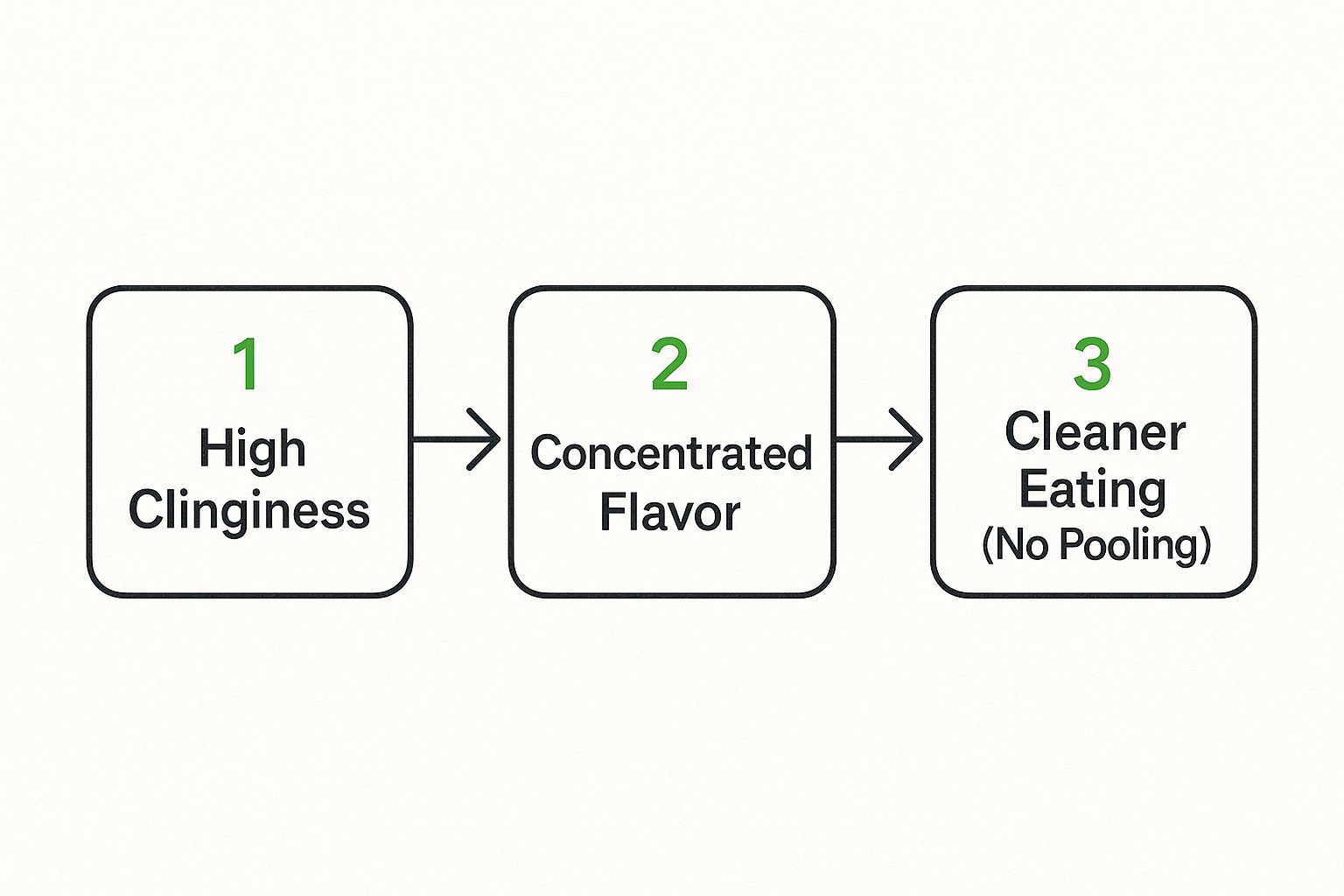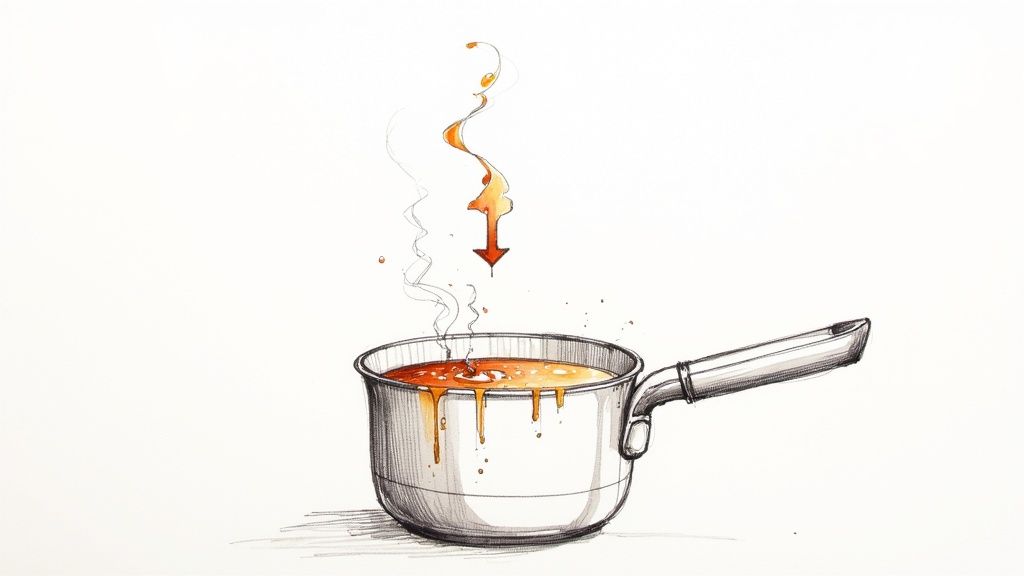There's nothing more disappointing than pulling a perfectly crispy wing out of the fryer, tossing it in sauce, and watching all that flavor slide right off onto the plate. We've all been there. The secret to making incredible, restaurant-worthy wings at home is all in the sauce's consistency.
Why a Thick Wing Sauce is a Game-Changer
A well-thickened sauce does more than just stick to the chicken. It creates a beautiful, glossy coating that ensures every single bite is packed with flavor. It’s the difference between a sad, watery puddle at the bottom of the bowl and wings that are perfectly coated and gloriously messy in all the right ways.
This simple skill is what separates decent homemade wings from truly unforgettable ones. It's all about making sure that sauce clings for dear life.

As you can see, better cling means more flavor and a much better eating experience. If you're stuck on what kind of sauce to make, you can always find a recipe by ingredients on hand and then use one of these techniques to get it just right.
The Cornstarch Slurry: A Quick and Glossy Fix

When you need a thicker sauce and you need it now, the cornstarch slurry is your best friend. This is the go-to technique for getting that beautiful, glossy sheen that makes wings look as good as they taste. It’s a classic for a reason—it’s fast, simple, and incredibly effective.
The whole process is straightforward. Just mix equal parts cornstarch and cold water in a small bowl. The key here is cold water; using warm or hot liquid will cause the starch to clump up before it ever hits your sauce.
Once you have a smooth, milky mixture, slowly pour it into your simmering sauce while whisking constantly. You’ll see the magic happen almost instantly as the sauce thickens up right before your eyes. It only takes a minute or two of simmering for the cornstarch to fully activate.
Pro Tip: Go easy at first. A little slurry goes a long way. I usually start with about 1 tablespoon of cornstarch (mixed with 1 tablespoon of cold water) for every cup of sauce. Remember, the sauce will get even thicker as it cools down, so it's better to add a bit more later if needed.
If you're converting a recipe and need to be precise, our cups to grams converter can be a lifesaver.
Choosing Your Starch Thickener
While cornstarch is a popular choice, it's not the only game in town. Different starches can give you slightly different results, so picking the right one depends on what you're trying to achieve.
Here’s a quick comparison to help you decide.
| Thickener | Best For | Key Tip |
|---|---|---|
| Cornstarch | All-purpose thickening; creating a glossy, translucent finish. | Always mix with cold water first to prevent lumps. |
| Arrowroot | Sauces you plan to freeze; creates a very clear, glossy sauce. | Add it at the very end of cooking—overheating can make it thin out. |
| Potato Starch | Thickening at lower temperatures; good for dairy-based sauces. | Has a silky texture but can become gluey if boiled too long. |
| Tapioca Starch | Creating a stringy, almost chewy texture; popular in Asian sauces. | Thickens quickly, so add it slowly and watch carefully. |
Ultimately, the best thickener is the one that gives you the exact texture you want for your wings. Don't be afraid to experiment to find your favorite.
Mastering the Roux for a Richer Sauce

When you're dealing with creamy sauces—think a classic Buffalo or a decadent garlic parmesan—a roux is your secret weapon. It’s a classic French technique that builds a deep, velvety base that a simple slurry just can't match.
The process is straightforward: you cook equal parts fat and all-purpose flour together before adding your liquid.
Building Your Roux
Start by melting your fat (butter is classic for its flavor) in a saucepan over medium-low heat. Once it's melted, whisk in the flour until it forms a smooth paste. Let it cook for at least a minute, stirring constantly. This crucial step cooks out the raw flour taste. You can explore a cooking oil smoke point chart to understand how different fats behave under heat.
The real key to a lump-free sauce is to add your warm sauce liquid to the roux little by little. Pour in a small amount and whisk like crazy until it's completely smooth before adding more. Keep doing this until all the liquid is incorporated.
Choosing your cookware matters here. The best healthy cooking pans offer even heat distribution, which helps prevent your roux from scorching.
A Note on Color and Power
The longer you cook a roux, the darker and nuttier it becomes, but it also loses some of its thickening ability. It's a trade-off between flavor and function. A dark brown roux, for instance, can lose up to 50% of its thickening power compared to a "white" roux that's only cooked for a minute or two. For most wing sauces, a light, blonde roux is all you need.
Intensify Your Sauce by Letting It Simmer

Sometimes the best way to thicken a sauce is also the simplest. You don't always need to add anything new. This classic kitchen technique, known as reduction, is all about letting your sauce simmer gently on the stove. As the excess water evaporates, the sauce naturally thickens up, and all those amazing flavors become deeper and more concentrated. It's a game-changer.
This is my go-to method for pure, straightforward sauces like a classic buffalo or a tangy BBQ. You want the core ingredients to be the star of the show, and reduction makes that happen.
For a typical buffalo sauce, a gentle simmer for just 10-15 minutes is usually all it takes to get that perfect, clingy consistency and an incredible depth of flavor. If you want to dive deeper, there's a great wing sauce thickening discussion on The Hot Pepper forum that gets into the nitty-gritty.
The key here is patience. Keep the heat low and let it bubble away slowly. If you get it too hot, especially with sugary sauces, it can scorch and ruin the flavor.
Pro Tip: Dip a spoon in the sauce. If it coats the back without immediately running off, you’ve nailed it.
Finishing Touches for a Perfect Texture
https://www.youtube.com/embed/8svMlwFIqeo
Sometimes, your sauce is just one simple ingredient away from being absolutely perfect. A few clever finishing touches, added right at the end, can introduce a whole new level of body and richness.
A classic trick I learned years ago is to whisk a pat of cold butter into the sauce right after you take it off the heat. This is an old French technique called monter au beurre, and it works wonders. It emulsifies the liquid, giving it a slight thickness and an incredible, glossy sheen that looks amazing on wings.
For a tangy buffalo sauce, try stirring in a spoonful of cream cheese. It melts down beautifully, creating a luxurious, creamy body that clings to every nook and cranny of the chicken. Don't be afraid to play with acidity, either; exploring different options like these substitutes for white wine vinegar can introduce some really interesting complexity to your final flavor.
When you're working with sweeter sauces, a little bit of honey or molasses can be your best friend. Just a touch adds that perfect stickiness and depth of flavor without making it overly sweet. It's all about finding that perfect balance.
To see how a well-made sauce comes together to create something special, take a look at The Ultimate Bar B Q Wings Recipe.
Troubleshooting Your Wing Sauce
Even the best recipes can go sideways. If you've hit a snag while trying to get that perfect, clingy wing sauce, don't sweat it. These are the most common issues I see, and thankfully, the fixes are simple.
"Help! My Sauce Is Way Too Thick."
We've all been there. You turn your back for a second, and your sauce turns into something closer to paste.
This is an easy fix. Just get the sauce back on low heat and whisk in a little more of your base liquid—whatever you started with, like broth, water, or even a splash of vinegar. The key is to add it one tablespoon at a time, stirring continuously until it loosens up to that perfect consistency.
"Will This Sauce Thicken Up as It Cools Down?"
Yes, it absolutely will. Any sauce thickened with starch (like cornstarch or flour) or a good amount of fat (like butter) will firm up significantly as it cools.
Here's my rule of thumb: cook the sauce until it's just slightly thinner than you ultimately want it. By the time it rests for a few minutes and you're ready to toss the wings, it'll have reached that perfect, clingy texture you were aiming for.
Pro Tip: Always aim for a consistency that's a little looser than your final goal while the sauce is on the heat. This simple trick accounts for the natural thickening that happens as it cools.
"How Do I Keep My Cornstarch Slurry From Getting Lumpy?"
Lumps are the enemy of a silky-smooth sauce. The secret to avoiding them is all in the slurry.
Before you even think about adding it to your hot sauce, make sure you mix the cornstarch with an equal amount of cold liquid. Whisk it vigorously until it forms a completely smooth, thin paste with zero clumps. Then, pour that slurry into your simmering sauce slowly while you whisk the main pot constantly. This ensures it dissolves evenly without creating those dreaded lumps.
And if you're curious how adding a slurry or a little extra butter might change the calorie count, this handy recipe calorie calculator can give you a quick breakdown.

